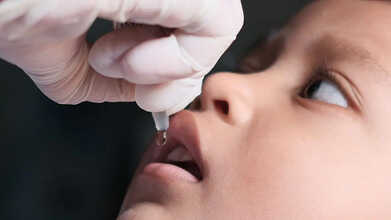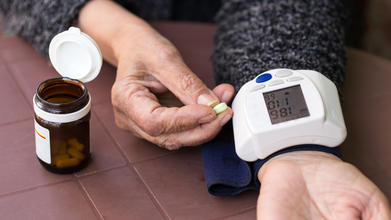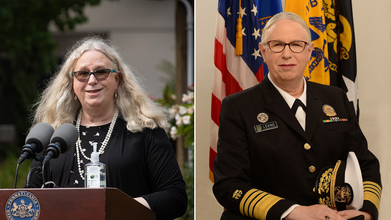- Health Conditions A-Z
- Health & Wellness
- Nutrition
- Fitness
- Health News
- Ayurveda
- Videos
- Medicine A-Z
- Parenting
Oral Cholera Vaccine Shanchol Gets WHO Prequalification; What You Should Know

Credits: Canva
The oral cholera vaccine Shanchol, made in Hyderabad and first developed by Shantha Biotechnics, has received World Health Organization (WHO) prequalification after its production was recently revived under new management. The clearance allows global procurement agencies such as UNICEF, Gavi, and PAHO to source the vaccine for countries where cholera continues to have a serious public health threat, according to GCBC Vaccines. With the approval in place, here’s a closer look at the vaccine, how it works, and why it matters.
Shanchol: What Is the Vaccine?
Dr. K.I. Varaprasad Reddy, founder of Shantha Biotechnics, said, “Shanchol was designed to be an affordable and accessible answer for countries that struggle with repeated cholera outbreaks. The WHO’s prequalification continues that mission.”
Shanchol is an oral, inactivated, bivalent cholera vaccine that protects against Vibrio cholerae, the bacteria responsible for the disease. The name itself is a brand term rather than an abbreviation.
How Does The Shanchol Vaccine Work?
Type of vaccine: Shanchol is a killed whole-cell vaccine, which means it contains dead cholera bacteria. These are used to train the immune system without causing infection. Being bivalent, it offers protection against the two major cholera strains, O1 and O139.
- Administration: The vaccine is taken by mouth and usually given in two doses for full protection.
- Mechanism: Once ingested, the vaccine activates the immune system in the gut, prompting it to produce antibodies that stop Vibrio cholerae from attaching to the intestinal lining. This prevents the infection from taking hold and causing illness.
Shanchol Vaccine: Why It Matters?
- WHO prequalification: The WHO’s approval confirms that Shanchol meets global standards for safety and effectiveness, making it eligible for international procurement.
- Part of global stockpile: It plays a key role in the world’s oral cholera vaccine stockpile, which supports emergency response efforts in regions hit by cholera outbreaks.
- Current use: Shanchol is widely used in mass immunization drives across cholera-prone and outbreak-affected regions.
Production Revival
Originally created by Shantha Biotechnics, the vaccine later came under Sanofi’s ownership, which eventually halted its production. Manufacturing has now resumed under GCBC Vaccines, part of the Gland Family Office. With WHO prequalification restored, Shanchol will once again be distributed globally to support vaccination programs.
The Role of Oral Cholera Vaccines
Oral cholera vaccines (OCVs) such as Shanchol and Dukoral are tools in preventing the spread of cholera, a severe diarrheal disease caused by Vibrio cholerae. Taken orally, they help trigger an immune response in the intestine that limits bacterial infection. These vaccines are especially valuable in areas with poor sanitation and limited access to clean water.
Vishy Chebrol, Executive Director of GCBC Vaccines, said the company’s priority is to ensure that vaccines reach the countries that need them most, affordably and consistently. “We are also working to bring more affordable and innovative vaccines to global markets, continuing Shantha’s legacy of improving access to life-saving immunization,” he added.
With WHO’s renewed approval, Shanchol, a bivalent, killed whole-cell oral cholera vaccine effective against Vibrio cholerae O1 and O139, will continue to be supplied worldwide to meet growing demand and support national immunization programmes.
One Dead, 21 Poisoned: California Sounds Alarm Over Toxic Death Cap Mushrooms; Here's How To Identify Them

Credits: iStock
Officials in California have now urged people to not forage for wild mushrooms after a rise in poisoning cases that caused at least one death. The California Poison Control System was able to identify at least 21 cases of poisoning in northern California. This has resulted from death cap mushrooms, confirmed the state's public health department.
How Bad Is The Mushroom Poisoning?
The poisoning has resulted in severe liver damage in people and have not spared even children. It has killed at least one of the patients who may have needed a liver transplant, confirmed the health department.
The problem is that death cap mushrooms could be easily mistaken for safe, edible mushrooms because of its similar taste, smell, and appearance.
What Do Health Officials Say?
Health officials have confirmed that the recent cases occurred between mid November and early December, a period marked by heavy rainfall in the region. The wet weather creates perfect conditions for the toxic death cap mushroom to thrive, especially around oaks and other hardwoods, including pine trees, according to the California Department of Public Health (CDPH).
While most cases have been concentrated in Monterey and the San Francisco Bay Area, the CDPH cautioned that the danger extends across California.
“Death cap mushrooms contain toxins that can cause life threatening liver failure,” said Dr Erica Pan, CDPH Director and State Public Health Officer. “Because these mushrooms can be easily confused with edible varieties, we strongly urge the public to avoid foraging for wild mushrooms during this high risk season.”
The agency stressed that death caps are unsafe under any circumstances. Cooking, freezing, boiling or drying them does not remove their toxicity.
Consuming the mushroom can trigger symptoms such as nausea, vomiting, watery diarrhoea, abdominal pain and dehydration within six to 24 hours. Although the discomfort may briefly subside, serious or even fatal liver damage can develop up to eight days later.
“Only individuals with significant expertise in identifying wild mushrooms should eat those they have harvested themselves,” Dr Edward Moreno, Health Officer for Monterey County, said.
Ways To Identify Death cap Mushroom
Inspect the cap: look for a green or yellow tint on top of the mushroom's white cap. The caps of mature mushrooms also have 1 to 2 large cracks running across them. Death caps often have 1 or more patches of thin, white, vein-like tissue.
A flat cap with diameter 3 to 6 inches: mature death caps are widely and nearly flat on top. However, young death caps have an almost spherical, bowl-shaped cap.
Gills underneath cap: the death mushroom cap has thin white gills on the underside of the cap.
Smell: hold the mushroom about 3 inches away from nose and take a sniff. A death cap mushroom shall smell slightly like ammonia or other chemical household cleaners.
Touch: Tap the death cap mushroom lightly so you do not break it off. The caps of death cap mushroom are often sticky and could leave a small amount of adhesive residue.
Look for white spores left behind: place the mushroom cap on a piece of dark colored paper with gills facing downward. Let the mushroom sit in this position and next morning lift up the mushroom cap and look for white spore print on the sheet. A death cap mushroom will leave a white spore print.
FDA Recalls High Blood Pressure Medication, Here's Why

Credits: iStock
A commonly prescribed blood pressure medication is being pulled from shelves after routine testing revealed possible contamination with another drug. Glenmark Pharmaceuticals Inc., which has its U.S. headquarters in Elmwood Park, New Jersey, has voluntarily recalled more than eleven thousand bottles of bisoprolol fumarate and hydrochlorothiazide tablets, sold under the brand name Ziac. The recall was announced in an online report published by the U.S. Food and Drug Administration.
Why the Drug Was Recalled
According to the FDA, reserve sample testing detected traces of ezetimibe, a medication used to treat high cholesterol. Glenmark manufactures both drugs, and officials say the presence of ezetimibe suggests the tablets may have been cross contaminated during production. The recall affects the 2.5 milligram and 6.25 milligram strengths of the medication, which is used to treat hypertension by helping the heart beat more normally, reducing fluid retention and relaxing blood vessels.
The recall has been classified as Class III, which is the lowest risk category. This means that although the product violates FDA standards, the agency does not expect the contaminated tablets to pose serious or immediate health risks. Class III recalls generally involve issues that are unlikely to cause adverse health consequences. However, the FDA still requires the manufacturer to remove the affected lots from circulation.
Products and Lots Included
The recall covers several bottle sizes packaged for the U.S. market. The affected National Drug Codes are:
- 30 count bottles, NDC 68462 878 30
- 100 count bottles, NDC 68462 878 01
- 500 count bottles, NDC 68462 878 05
According to the FDA report, the impacted lots include Lot 17232401, which has an expiration date of November 2025, and Lot 17240974, which expires in May 2026. The tablets were manufactured in Madhya Pradesh, India for Glenmark’s U.S. division. In total, more than eleven thousand bottles are part of the recall.
What Patients Should Know
Neither Glenmark Pharmaceuticals nor the FDA has issued specific instructions for patients who may have the recalled medication at home. However, standard guidance from GoodRx and other pharmacy resources advises patients to take a few simple steps. Individuals should check the lot number on their medication bottle and compare it with the recalled lots. If the numbers match, patients are encouraged to contact their pharmacist or prescriber to discuss next steps. Most pharmacists will recommend safely discarding the recalled medication and arranging for a replacement prescription.
While the contamination involves only trace amounts of another drug and is not expected to cause serious harm, health experts note that taking medication that has been compromised in any way is not advisable. Patients who rely on bisoprolol fumarate and hydrochlorothiazide for blood pressure control should not stop treatment abruptly without consulting their healthcare provider.
Understanding the Medication
Bisoprolol and hydrochlorothiazide is a combination drug that lowers blood pressure by blocking beta 1 receptors in the heart, increasing urination to remove excess sodium and water, and relaxing blood vessels. It is commonly prescribed to reduce the risk of heart attacks and strokes in patients with hypertension.
With the recall in place, patients are encouraged to stay alert, review their medication labels and reach out to their healthcare team if they believe they have received an affected batch.
Trump Administration Deadnames Transgender Former HHS Officer Rachel Levine in Official Portrait

Credits: iStock
It is no news that ever since the President Donald Trump's administration has signed in, transgenders have seemed to lost their rights, with their research being removed, defunded, and now the administration has changed the name of transgender health leader on her official portrait. The new name used is her head name.
The person in question is Adm. Rachel Levine, who made history in 2021 when she was sworn in as the assistant secretary for health at the Department of Health and Human Services under former President Joe Biden. Levin was nation's highest ranking and openly transgender federal official. Her portrait hands in the HHS office, along with pictures of other federal officials who have led the US Public Health Corps. However, recently, especially after the US government went on a shutdown, HHS has removed Levine's name from her portrait and replaced it with her dead name, reported NPR.
As per the GLAAD, formerly Gay & Lesbian Alliance Against Defamation, a major LGBTQ media advocacy organization, the act of revealing or using a transgender person's birth name without their permission is known as deadnaming.
What Does Levine Say On The Act Of Deadnaming Her?
Adrian Shanker, a former deputy assistant secretary for health policy in the Biden administration and Levine's current spokesperson told the NPR that this act is of "bigotry against her".
“During the federal shutdown, the current leadership of the Office of the Assistant Secretary for Health changed Admiral Levine's photo to remove her current legal name and use a prior name," Shanker told the outlet.
As per Levine, it was a “great honor to serve in the United States Public Health Service Commissioned Corps.” In a statement to The Independent, she said, "My focus has been and continues to be on public health and health equity. I am not going to comment on this type of petty action.”
While the HHS spokesperson Andrew Nixon told that the agency's priority "is ensuring that the information presented internally and externally by HHS reflects gold standard science. We remain committed to reversing harmful policies enacted by Levine and ensuring that biological reality guides our approach to public health," in a statement to NPR.
Trump Administration Against Transgender
Over the last year, Trump administration has rolled back many rights of transgender people.
The U.S. Department of Health and Human Services (HHS) released new definitions for 'sex,' 'man,' and 'woman', an action that has provoked widespread discussion in health, scientific and policy communities. While proponents believe the revisions bring back biological truth, opponents caution that they will weaken science and harm healthcare policies. On February 19, HHS Secretary Robert F. Kennedy Jr. released new federal guidelines that strictly define sex as an unchanging biological category based on reproductive function. The memo claims that sex is genetically determined at birth and does not change throughout life, making it clear that biological sex cannot be altered by medical treatment or self-identification.
The government of the United States abruptly terminated at least 68 grants which were awarded to 46 institutions. This was a total of $40 million in funding. These grants were supporting research which was related to LGBTQ health, and included HIV prevention, youth suicide, cancer and bone health. While some of these funds have already been used, at least $1.36 million was withdrawn from future support. This figure is also an undercount, as estimates were available only for a portion of the cancelled grants.
A new law in South Dakota has restricted transgender people's use of communal facilities in public schools and state-owned buildings. This was implemented from July 1 2025.
The Centers for Disease Control and Prevention (CDC) retracted references to transgender people, gender identity, and equity from its website. This change followed the executive order and a directive from the Federal Office of Personnel Management instructing agencies to eliminate taxpayer-funded programs reflecting "gender ideology". The guidelines issues on Wednesday asked to end "all agency programs that use taxpayer money to promote or reflect gender ideology", and was signed by President Trump.
© 2024 Bennett, Coleman & Company Limited

